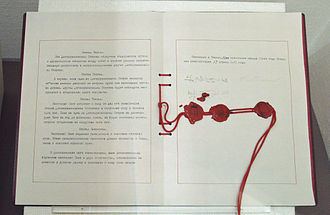 | ||
The Soviet–Japanese Neutrality Pact (日ソ中立条約, Nisso Chūritsu Jōyaku), also known as the Japanese–Soviet Non-aggression Pact (日ソ不可侵条約, Nisso Fukashin Jōyaku), was a pact between the Soviet Union and the Empire of Japan signed on April 13, 1941, two years after the brief Soviet–Japanese Border War (1939). The pact was signed to ensure the neutrality between the Soviet Union and the Empire of Japan during World War II, in which both countries participated.
Background and history
After the Fall of France and the subsequent expansion of the Axis Powers, the Soviet Union wished to mend its diplomatic relations in the Far East in order to safeguard its eastern border and concentrate on the European theatre of war. On the other hand, Japan, bogged down in a seemingly interminable war with China and with diplomatic relations with the United States rapidly deteriorating, sought an accommodation with the Soviet Union that would improve its international standing and secure the northern frontier of Manchukuo against possible Soviet invasion.
Stalin was initially unaware of Hitler's briefing to his generals that an attack on the Soviet Union by the European Axis Powers would enable Japan to challenge the United States overtly. This briefing was based on the belief that if such an attack occurred, the Soviet Union would be too preoccupied with fighting Germany, thus making Japan feel less threatened by any possible Soviet invasion of Manchukuo, allowing Japan to have enough provisions and capabilities to start a war with the United States. This treaty Stalin made would allow neither Japan nor the Soviet Union to have to fight in multiple fronts. Stalin believed that his "problems can be solved in a natural way if the Soviets and the Japanese cooperate". After concluding the nonaggression treaty, Stalin, in an unprecedented gesture, saw Foreign Minister Yosuke Matsuoka off at the train station. This was symbolic of the importance Stalin attached to the treaty; it also provided him with the occasion – in the presence of the entire diplomatic corps – to invite negotiations with Germany while flaunting his increased bargaining power.
The treaty was signed in Moscow on April 13, 1941, by Foreign Minister Yosuke Matsuoka and Ambassador Yoshitsugu Tatekawa for Japan and Foreign Minister Vyacheslav Mikhailovich Molotov for the Soviet Union.
On the same day, the same people also signed a declaration regarding Mongolia and Manchuria. The Soviet Union pledged to respect the territorial integrity and inviolability of Manchukuo, while Japan did the same for the Mongolian People's Republic.
Later, in 1941, Japan, as a signatory of the Tripartite Pact, considered denouncing the Soviet–Japanese Neutrality Pact, especially after Nazi Germany invaded the Soviet Union (Operation Barbarossa), but made the crucial decision to keep it and to expand southwards invading the European colonies in Southeast Asia instead.
On April 5, 1945 the Soviet Union denounced the pact, informing the Japanese government that "in accordance with Article Three of the above mentioned pact, which envisaged the right of denunciation one year before the lapse of the five-year period of operation of the pact, the Soviet Government hereby makes known to the Government of Japan its wish to denounce the pact of April 13, 1941." The wording of the denunciation suggested that the Soviet Union wished to see the treaty go out of effect immediately, and Time magazine reported that the Soviet Foreign Commissar's tone indicated that the Soviet Union might go to war with Japan soon. However, the text of the treaty clearly stated that the pact remained in force until April 1946. When pressed by the Japanese Ambassador Naotake Sato, Molotov confirmed that the treaty did remain in force until April 1946.
On August 9, 1945, just after midnight, the Soviet Union invaded Manchuria. The declaration of war followed nearly six hours later. Since the time zone difference of 7 hours, the declaration of war could be still dated August 8, 1945, being handed in Moscow at 11 p.m.
